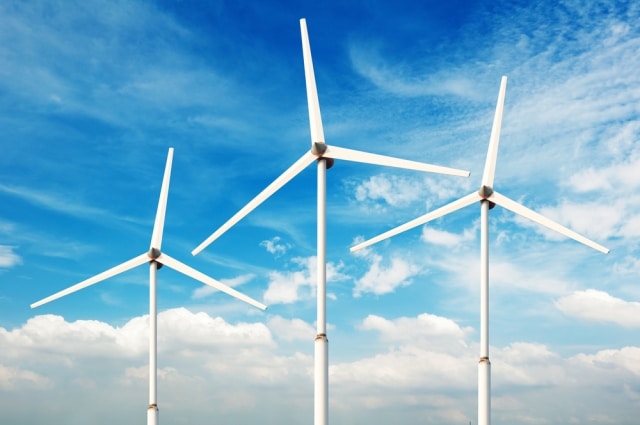More than 160 countries are now consciously uncoupling from fossil fuels by adopting renewable energy policies and targets, which helped make 2014 the first year in the past four decades that economic growth was not accompanied by a rise in carbon emissions, according to a new report.
The 10th annual edition of REN21‘s Renewables Global Status Report found that, despite 3 percent growth last year in the global Gross Domestic Product and a 1.5 percent increase in energy consumption, CO2 emissions levels held steady at 32.3 billion metric tons, the same as in 2013.
Alexander Ochs, director of the climate and energy program at Worldwatch Institute, which collaborated with REN21 on the report, says that the findings of this report bode well for the outcome of UN climate negotiations due to be held this December in Paris.
“For the first time in decades, energy-related greenhouse gas emissions leveled out while GDP continued to grow in 2014,” Ochs said in a statement emailed to DeSmog. “This encouraging trend is due to the remarkable success of renewables. It should energize all efforts to make the important climate summit in Paris in the end of this year a success story as well.”
Solar and wind continued their astronomical growth trajectories. More than 51 gigawatts (GW) of wind capacity was added globally in 2014, per REN21’s report, representing a 44 percent increase over 2013.
The world total is now close to 370 GW. Wind power provided more than 20 percent of electricity generation in several countries in 2014, including Denmark, Nicaragua, Portugal and Spain, the report says.
Meanwhile, the report found that rapidly falling costs continued to make solar photovoltaic technology (solar PV) increasingly cost-competitive, leading to a record-breaking 40 GW of new capacity in 2014 that brought total global capacity to 177 GW. The top three markets for solar PV — China, Japan and the US — accounted for the “vast majority” of new capacity, according to the report.
The top five countries in terms of dollars spent on renewables in 2014 were China, the US, Japan, the UK and Germany.
As renewables like solar and wind scale up, they are reducing our reliance on fossil fuels, and the Renewables Global Status Report has the numbers to prove it. Global investment in renewable energy was more than twice that of investment in net fossil fuel power capacity in 2014, the report found, noting that that continues the trend of renewables outpacing fossil fuels in net investment for the fifth year running.
Employment in the renewable sector grew to an estimated 7.7 million people worldwide in 2014.
Level Playing Field Still Very Much Needed
If you don’t include hydropower projects with a generating capacity of more than 50 megawatts (MW), new investment in renewable power and fuels grew worldwide by 17 percent over 2013, to some $270.2 billion.
If you include large-scale hydropower, that number becomes $301 billion — but even as investors are aggressively targeting the world’s tropical river basins for major construction of hydropower dams, there are a number of questions about how sustainable these projects really are.
Though total global investments in renewables topped $300 billion in 2014, the authors of the 2015 Global Status Report find that much more effort is needed in heating and cooling as well as in transportation to convert to renewable energy. The use of modern renewables is growing in these sectors, the report found, but still constitute a very small portion of the overall market.
For instance, while renewable energy supplied more than a quarter of energy use for heating, two-thirds was traditional biomass — which, like hydropower dams, has been criticized as not being a truly sustainable source of energy. True renewables like wind and solar supplied the remaining third of heating energy, just 8 percent of the world’s total final energy use for heat production.
But the renewable sector’s overall growth could be even greater if not for certain government policies, especially the more than $550 billion in annual subsidies provided to fossil fuels and nuclear energy, which the report says is responsible for keeping prices “artificially low” for energy prices from those sources.
“Creating a level playing field would strengthen the development and use of energy efficiency and renewable energy technologies,” Christine Lins, executive secretary of REN21, said in a statement. “Removing fossil-fuel and hidden nuclear subsidies globally would make it evident that renewables are the cheapest energy option.”
A Real Solution To Global Poverty
There’s plenty of evidence in the report that renewable energy technologies are a true solution to global energy poverty, as well.
Fossil fuel companies, most notably Peabody Energy, the world’s largest privately held coal company, have been pushing their product as the only solution to “energy poverty,” which they say is a more dire global crisis than climate change in an attempt to reframe the debate about how we power our society.
According to the 2015 Renewables Global Status Report, more than one billion people, 15 percent of humanity, still lack access to electricity. Africa has less power generation capacity than Germany, for instance. But distributed renewable energy technologies are improving the situation, the report found, by providing energy in remote, rural areas.
As an example, the report cites off-grid solar PV, which attracted investment of roughly $64 billion in 2014 and is a “significant and growing market presence.”
The report found that investment in renewable energy by developing countries hit $131.3 billion last year, up 36 percent from 2013. That’s the closest it’s ever come to equalling investments by developed economies, which invested $138.9 billion in 2014, a modest 3 percent over 2013.
China accounted for 63 percent of investment by developing countries, but Chile, Indonesia, Kenya, Mexico, South Africa and Turkey each invested more than $1 billion in renewable energy.
Image Credit: gui jun peng / Shutterstock.com
Subscribe to our newsletter
Stay up to date with DeSmog news and alerts







